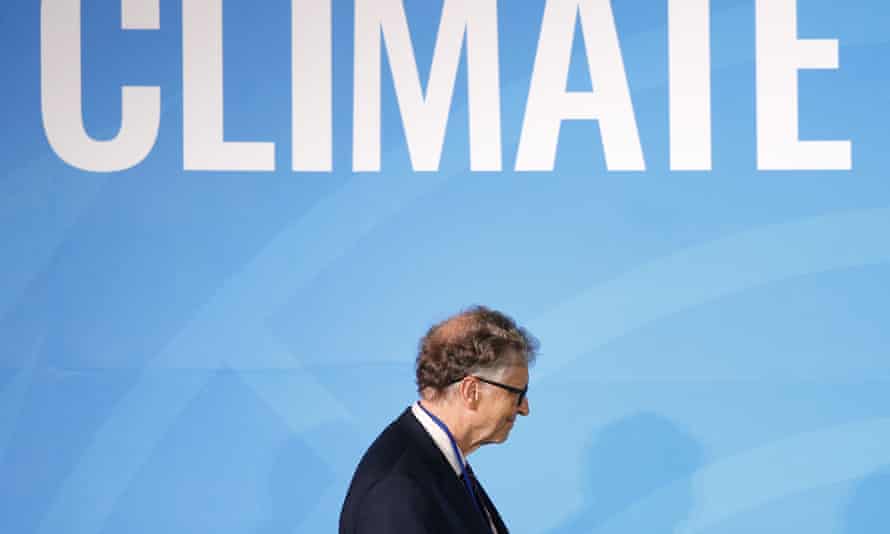Elizabeth Kolbert’s favourite movie is the end-of-the-world comedy Dr Strangelove or: How I Learned to Stop Worrying and Love the Bomb. For those who need a quick recap, this cold war film features a deranged US air force general who orders a nuclear attack on the Soviet Union using weapons developed by a mad Nazi scientist played by Peter Sellers. A last-minute glitch almost forestalls an apocalyptic war, but a gung-ho B-52 pilot has other ideas. He opens the bomb doors and mounts the H-bomb as if it were a horse, waving his hat and whooping as he rides the missile towards the world’s oblivion. No heroism could be more misguided. No movie could end with a blunter message: how on Earth can we humans trust ourselves with planet-altering technology?
The same absurdly serious question lies at the heart of Kolbert’s new book, Under a White Sky. The Sixth Extinction, her previous book, won a Pulitzer prize for its investigation into how mankind has devastated the natural world. Now she has widened her gaze to whether we can remedy this with ingenious technological fixes – or make things worse. “There was definitely a question left hanging: now we have become such a dominant force on planet Earth, and created so many problems through our intervention, what happens next?”, she says.

In Under a White Sky she examines cutting-edge scientific advances: how much hope can we place in gene-modification, geoengineering and assisted evolution? To what extent can we repair the mess we have made? Thanks to humans, the planet is heating dangerously fast, there is now more carbon dioxide in the atmosphere than at any time in millions of years, the extinction rate of other species is hundreds, maybe thousands, of times above natural levels, and just about every planetary warning gauge is heading further into the red. Are there mega-solutions out there for these mega-problems?
One of the most advanced geoengineering plans under discussion is to simulate a volcano eruption by filling the atmosphere with a million tonnes of sulphur dioxide each year to reflect the heat of the sun back into space. Scientists calculate this cooling effect would offset human-caused global heating, but the benefits would be temporary and unevenly distributed. To prevent the temperature from jumping back up, repeated applications would be needed, potentially causing catastrophes in some parts of the world to save others. Kolbert says this, at best, might buy a little time, but at worst could make life impossible for millions. Among the potential side effects are conflict, acid rain, ozone layer depletion, lower power generation from solar panels and an alteration of the spectrum of light so profound that the blue heavens would fade and leave us all living under a white sky.
The last time the world’s air was filled with so many particles was after Mount Tambora blew in Indonesia in 1815. This led to a year of endless winter in some parts of the world. In the US, one writer observed: “The very face of nature seemed to be shrouded in a deathlike gloom.”
Kolbert’s book is a meticulously researched and deftly crafted work of journalism that explores some of the biggest challenges of our age. It also manages to be wickedly funny. Some passages read like an absurdist novel by Kurt Vonnegut or Joseph Heller. As in Cat’s Cradle or Catch-22, humanity is trapped within an ever more vicious circle created by its own skewed logic and techno-dependency. As the author writes early on, this is “a book about people trying to solve problems created by people trying to solve problems”.
“I hope the book is a bit of a dark comedy,” says Kolbert, who writes for the New Yorker, over Google Chat from her home in Massachusetts. “I am trying to turn something of that Strangelove sensibility on this grave and depressing problem. I want to make people think but in a way that is not unrelentingly grim. Whether to laugh or cry has always been a fine line.”
So far, the Anthropocene is not going so well: humans, she notes, have transformed half the ice-free land on Earth, dammed or diverted most of the world’s major rivers and emitted about a hundred times more carbon dioxide than volcanoes. In terms of biomass, people and our domesticated animals now outweigh wild mammals by a ratio of 22 to 1. From nuclear bomb test fallout to microplastics, signs of our presence are everywhere.
Under a White Sky reflects on “our habit of mind – that when we come up against one of these problems we try to come up with the technology to solve it. That is a profound thread in recent human history. How it plays out is perhaps the crucial question in the coming century.”

Technology by itself is not intrinsically bad. Much of it, vaccine technology for example, is brilliant and beneficial – at least to humans. But invention often originates in short-term or siloed thinking. And even more frequently, its application fails because of political and economic decisions taken with little heed for non-humans and future generations.
Even the great environmentalist Rachel Carson cannot escape the irony of history. In one passage, she is admiringly quoted as observing: “The ‘control of nature’ is a phrase conceived in arrogance, born of the Neanderthal age of biology and philosophy, when it was supposed that nature exists for the convenience of man.” A few pages later, however, we discover that Carson’s warnings about pesticides and herbicides were used as an excuse for river managers in Arkansas to cut costs. Instead of upgrading treatment plants, they imported Asian carp to eat nitrogen-overloaded algae. This was supposed to be a “natural solution”. Unfortunately, the carp escaped from the treatment ponds and devastated the Mississippi river system.
Kolbert tracks the unfolding disaster as the carp problem grew bigger and bigger and the proposed solutions became more and more outlandish – physical barriers, electrification, poisoning, bubble-and-noise deterrents, bounty fishing and an $18bn hydrological separation scheme drawn up by the United States Engineering Corps. Military interventions crop up again and again in the book, underscoring how the old idea of conquering nature has never really gone away.
Instead of changing ourselves, we adapt the environment. “It was easier to imagine changing the river… than changing the lives of the people around it,” Kolbert writes.

Our pursuit of convenience is accelerating the destruction of the natural world. Kolbert’s considers the 19th-century extirpation of buffaloes, moose, cougar, beaver, wolverines, wild turkey and eastern elks, which she attributes in part to the inventions of railways and repeating rifles. Back then, extinctions were still considered shocking. To commemorate the demise of the passenger pigeon, Aldo Leopold wrote: “For one species to mourn the passing of another is a new thing under the sun.” Now, however, it is so common as to be banal. Scientists estimate that 150 species are lost every day due to land conversion, road expansion, chemical use and global heating.
For many species, survival is no longer about being the fittest in the wild; it’s about fitting in best with mankind. The creatures that abound are livestock, domestic pets and semi-parasitic synanthropes such as rats, crows and foxes that live off our waste. Most other populations are plummeting, though humans have the power to put certain endangered species on life support.
A jaw-dropping chapter explores the lengths the US goes to protect the Devils Hole pupfish. This tiny creature lived in a single underground pool in Nevada that was being sucked dry in the 1970s by nearby farm irrigation. Numbers declined to just a few dozen, prompting a bumper-sticker campaign, a congressional debate and a supreme court conservation order. Since then, the entire Devils Hole pupfish population – which weighs less than a single Filet-O-Fish – have been transplanted to a simulacrum, built at a cost of $4.5m and monitored by cameras and a team of four full-time staff. At one point, the ratio was one fishkeeper for every 16 fish.
Over the past two centuries, we have decimated the collective value of species and habitats, and then congratulated ourselves on saving a small number of survivors in an artificial environment. Pupfish are among thousands of similarly “conservation reliant” species that have to be hand-reared, medically assisted, guarded in enclosures or guided in migration. In another of those absurdist twists, “protecting” the wild increasingly means encasing it.
“We get to hear about stories when a population is down to the last survivors and only then is there a big push. It’s how the human mind works. We don’t pay attention until a crisis point is reached, and by then it is extremely difficult,” Kolbert says. She describes animals on life support as “Stockholm species” – captives that become accustomed to their prison. The same term might be used to describe humans, who also come across as trapped in the pursuit of more domination, which requires the development of ever more disruptive technology. It’s an escalator we can’t get off. “We are deep into this,” Kolbert says. “There are no easy answers. There is no way we can all go back to hunter-gatherer society. That isn’t happening.” But surely there are alternatives. I tell Kolbert I liked the book but wish it had delved into other options – politics, economics, culture, education, nature-based solutions. Humans used these levers to address problems before the advent of carbon-fuelled capitalism in the late 18th century.
The United States, though, pays little heed to its pre-industrial history. The country’s identity is deeply enmeshed with technology, which is treated as the great enabler of progress and freedom. It has also long been used as an excuse for climate inaction. In the late 1980s, the first President George Bush backed away from fossil fuel controls partly on the grounds that the climate problem would likely be solved by future inventions. That has become a mantra for Republicans ever since. Under the Trump presidency, US climate diplomats focused on largely unproven carbon capture technology in the future rather than emissions cuts now.

Under a White Sky is one of three high-profile books recently published on the climate crisis. Another is by Bill Gates, who proposes an unapologetically US-technocapitalist approach in his book How to Prevent a Climate Disaster. It reads like a cross between a planetary instruction manual and a “Global Warming for Dummies” guide. The Microsoft co-founder suggests what might be described as a global systems upgrade to fix the bugs in the planet and reveals that he is investing in most of the proposed technological solutions, including direct air capture, meat substitutes and fertiliser alternatives. He makes a very strong business case for change. But there is little evidence Gates is willing to think outside the techno-economy he helped to create. It could be argued he is simply being pragmatic. After all, upgrades are easier than reinventing a system from scratch. They are certainly more politically palatable to those in power. But what if the system itself is the problem?
When I challenge Kolbert on her techno-fatalism, she agrees that she looks on these technologies “with a jaundiced eye and a degree of horror. But I do see it as the overriding pattern. I don’t see us moving in another direction.” Though it “is definitely a step forward when someone as eminent as Bill Gates is assessing what technologies we need.”
Her book concludes with the ultimate example of fiddling with the planetary controls: the kind of geoengineering that might produce a white sky. This section could almost be printed in red with a warning sign, “Do not open, except in the event of a catastrophe – and even then think twice.” Solar radiation management, ocean seeding and other efforts to fix the world’s thermostat are no mere tweaks, no simple re-wiring jobs. Some of the scientists involved tell Kolbert they hope their research will never be applied. One says he is studying this topic now simply to avoid ill-informed decision making later. She also quotes a revealing exchange between two scientists at Harvard University. “Geo-engineering is not something to do lightly. The reason we are thinking about it is because the real world has dealt us a shitty hand,” one advocate says. “We dealt it ourselves,” the other replies.

When I ask Kolbert if she thinks we will see manipulated white skies in her lifetime, she says it depends first on the still uncertain speed of climate change, and then on who is making the decisions. “If we are on the luckier side and things happen more slowly or warming is on the lower end of estimates, then maybe we will avoid that conversation. But I don’t know if it will be a conversation. It could be small group of powerful nations making decisions for everyone. So will we see a white sky in my lifetime? I don’t think so. But in my kids’ lifetime? That is not impossible.”
She is clearly uncomfortable about the direction of travel. The technology can’t take us back to an undisturbed world. Instead, we are are heading towards a future in which humanity will be constantly reinventing our planet. Her book considers plans to use robots to manage coral reefs and the building of concrete barriers to hold greenland glaciers in place, but such efforts to buy time cannot last indefinitely. As one pithy Danish interlocutor puts it: “Pissing in your pants will only keep you warm for so long.” Soon humanity will need another fix that will likely create another problem.
“We are as gods and we might as well get good at it,” Stewart Brand, editor of the Whole Earth Catalog, wrote in its first edition in 1968. This view was later dismissed by the eminent biologist EO Wilson, who stated: “We are not as gods. We are neither intelligent or sentient enough to be much of anything.” More recently, the British writer Paul Kingsnorth took a different tack again. “We are as gods but we have failed to get good at it … We are Loki, killing the beautiful for fun. We are Saturn devouring our children.”
I ask Kolbert which of these three views are closest to her own. “That is the question at the heart of the book,” she responds. “Are we gods or are we just bumbling, technologically advanced creatures? As Ed Wilson also said: ‘We have paleolithic brains, we have medieval institutions and space-age technologies.’ That is a really dangerous combination and we are seeing that.”
Such philosophical considerations lift this book out of the ordinary. I wish Kolbert had gone further still. We have forgotten or ignored that our planet is already a technological marvel – the only life-support system that we know of in the universe. Strengthening that natural system is surely the goal our smartest brains should be focused on. After all, it has been done before. Archeologists have discovered evidence that much of the Amazon rainforest is anthropogenic – fruit trees and medicinal plants cultivated by the indigenous communities who have lived there for millennia. Such nondisruptive technology might also be called wisdom.
The third of the three big new environment books, The New Climate War by Michael Mann, goes furthest in this regard, with a strategic, wide-ranging overview of humanity’s present predicament and an exploration of possible pathways out of it. He champions overall system change to decarbonise our civilisation. This involves ethics, politics, finance, communication, psychology, behaviour and belief. Technology, in the forms of wind, solar and other renewables is an important part of the picture, but Mann – a veteran climate scientist – warns against over-reliance on unproven fixes such as geoengineering, that distract from simpler, cheaper, safer alternatives.
“Geoengineering appeals to free-market conservatives, as it plays to the notion that market-driven technological innovation can solve any problems without governmental intervention or regulation,” he writes. “A price on carbon, or incentives for renewable energy? Too difficult and risky. Engaging in a massive, uncontrolled experiment in a desperate effort to somehow offset the effects of global warming? Perfect!”.
While Kolbert takes a journalistic position of wry detachment, Mann is a sociopolitical activist. I ask Kolbert if she has ever considered following the example of Bill McKibben, a former New York Times writer who has become a leading climate campaigner. “Absolutely, I also thought about it. What is most useful thing for me to be doing?” she says. “McKibben has had an incredible impact. He is very good at it, very inspiring. But I don’t think that is where my own strengths lie.”
I ask her how her optimism-pessimism dial has shifted since the election of Joe Biden. “It has moved from: ‘We are doing the stupidest possible things given the situation’, which is where my needle was for the past four years. Now in the US at least, we have smart and committed people thinking about these questions. We have an interior secretary that for the first time in history is a native American. I think she will have very different priorities from many of her predecessors. But how much influence can one presidency have on the great forces of history?”
Has writing the book made Kolbert more or less enthusiastic about human interference? “My adventures with some of these scientists who work on really cutting-edge projects with gene editing, with carbon dioxide removal, with geo-engineering, did force me to confront some of my own deep seated and unexamined mental habits,” she answers.
“The question of how to feel about that – whether we are entering a brave new world that is exciting or a brave new world that is horrifying, I hope to leave that up to you.”


Average Rating